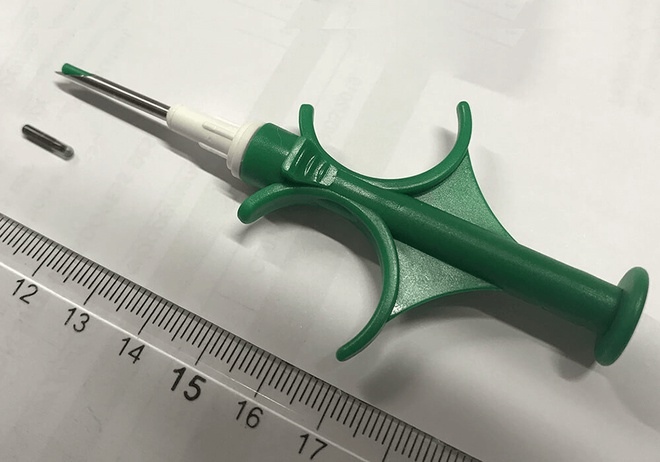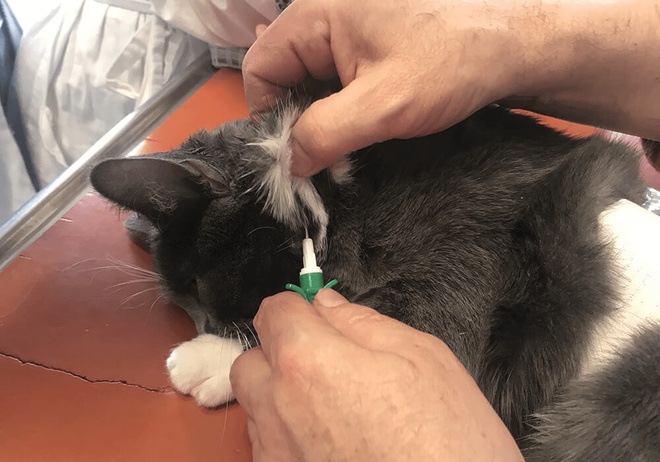How to find a lost cat or dog with a microchip?
It’s the experience every animal lover dreads: losing their beloved pet. It’s unfortunate, but pets in general—and cats and dogs that spend time outside in particular—do go missing. It can happen to anyone—even the most responsible and loving pet owner.

Reading time : 6 min
According to the American Humane Association, over 10 million dogs and cats are lost or stolen in the United States every year. What’s more, only 15 percent of dogs and a mere 2 percent of cats in shelters without ID tags or microchips are ever found by and reunited with their human families. There are many ways to search for a lost pet, but clearly, the most effective tool for locating a missing dog or cat is a microchip.
TOPICS
What’s a “Microchip?”

A microchip is a tiny, rice-sized device that is embedded just beneath your pet's skin, usually just between the shoulder blades in the case of cats and dogs. It contains a unique identification number that can be read with a microchip scanner. If your pet is ever lost and found, most shelters and veterinary clinics can simply scan this microchip to identify your pet and contact you.
Many pets can wear microchips, including horses, birds, ferrets, rabbits, and Guinea pigs, but the most common are cats and dogs. Microchips are typically about a centimeter in size, but this varies according to the size of the animal. Another slight difference is the frequency at which they operate. In the United States, most microchips for dogs operate at a frequency of 134.2 kHz, while most microchips for cats operate at a frequency of 125 kHz. This difference in frequency is not significant and does not affect the ability of the microchip to identify the animal.
How to register your pet on an online database in the United States

Registering your pet's microchip is essential to ensure your pet can be identified if lost. Here are the steps to register your pet on an online database in the United States:
- Choose a microchip registry: There are several microchip registries available, such as HomeAgain, AKC Reunite, and Found Animals. Choose one that best fits your needs.
- Register your pet's microchip: To register your pet's microchip, you'll need to provide your contact information and your pet's information, such as name, breed, age, and color.
- Keep your contact information up to date: It's crucial to keep your contact information up to date with the microchip registry. If you move or change your phone number, make sure to update your information with the registry. You should also alert the registry if you are traveling extensively, as many cats and dogs get lost when they move to another home for the holidays.
- Pay the registration fee: Most microchip registries charge a one-time registration fee, ranging from $10 to $50. Some may also offer additional services, such as pet insurance or travel assistance.
- Consider enrolling in a pet recovery service: Some microchip registries offer pet recovery services that can help with finding your lost pet. These services may include lost pet alerts, lost pet posters, and access to a 24/7 pet recovery hotline.
Find out the 5 most important steps to find your lost pet
All the information you need to find your beloved companion
How to find a lost cat or dog with a microchip

Contact microchip registry
First, you’ll need the 9-, 10- or 15-digit microchip number. Most veterinarians and rescue organizations can scan and provide you this information.
Next, you can use the 9-, 10- or 15-digit microchip number (no spaces or punctuation) to get a list of registries to contact to find pet owner information. Next, contact the microchip registry. If you don't know which registry your pet's microchip is registered with, you can search for it on the American Animal Hospital Association (AAHA) website. Once you have the registry's contact information, call them to report your pet missing and make sure your contact information is up to date.
Contact authorities and animal rescue
Be sure to contact local animal shelters and veterinary clinics as well to report your pet missing. Provide them with your pet's microchip number, and make sure they have your current contact information.
Share online
Third, posting on social media can be helpful, particularly if you have a lot of followers or contacts who can in turn spread the word. Post a picture and description of your pet on platforms like Facebook, Twitter, and Instagram. Of course, you should ask your friends and family to share the post to increase the visibility of your search.
You can also share a Lost Pet announcement on websites such as NextDoor or using Pawboost, a free website that mobilizes animal lovers in your area to find your lost pet.
Make lost-pet flyers
Create lost-pet flyers with your pet's picture and contact information, and post these in public places where permitted and distribute them in your local area. You can post them in pet stores, veterinary clinics, and public places like parks and community centers. You can offer a reward, but it’s not necessary.
Do not give up!
Remember that you finding your lost cat or dog could take time, but you should not give up. Make sure to follow up with your pet's microchip registry and the local animal shelters and veterinary clinics regularly. Keep them updated with any new information about your search.
How a GPS tracker can provide pet owners extra security?

While microchips are an essential tool for reuniting lost pets with their owners, they have a few limitations. For example, a microchip can only help identify your pet if it's found by someone with a microchip scanner. A GPS tracker, on the other hand, can provide pet owners with real-time location information about their pets, making it easier to find them if they get lost and before they stray too far.
GPS tracker vs Microchip, what is the difference?
Unlike a microchip that’s implanted beneath the skin, a GPS tracker is an exterior device that is attached to and worn with your pet's collar or harness. It uses GPS technology to track your pet's location and sends live data to your phone or computer. Whereas a microchip could be compared to your pet’s ID. It only enables you to identify your pet when found not to track them.
The benefits of using a GPS tracker
Benefits of using a GPS tracker for your pet include:
- Real-time and no distance limit location tracking: With a GPS tracker, you can see your pet's location wherever they are and in real-time, making it easier to find them if they get lost. Especially because pets move quickly and run far when lost or afraid. That’s why the real-time feature is essential.
- Training your pet: Some GPS also includes vibrating or ringing features. These are very helpful to train your pet to recall, to come and eat or to come back home at the end of the day. These are extremely useful to minimize the risk of losing them or finding them quicker.
- Geofencing: Sometimes, you can also set up a geofence, which is a virtual boundary around a specific area. If your pet leaves the designated area, you'll receive an alert on your phone.
- Activity tracking: Some devices can also track your pet's activity levels, including how much they're walking, sleeping or playing. It enables to detect potential health issues, changes of habits, and better understand how your pet is feeling.
- Peace of mind: Knowing where your pet is at all times can provide pet owners with peace of mind, especially if their pet has a history of running away or getting lost.
Microchip and GPS trackers: two complimentary devices

Let's review the important differences between these two small technologies and how—when used together—they can protect your pet even better.
A microchip is a small electronic chip that is implanted under the skin of your pet, typically on the back of the neck. It contains a unique identification number that is linked to your contact information in a database. If your pet ever gets lost, a veterinarian or animal shelter can scan the chip to retrieve your information and reunite you with your pet.
On the other hand, a microchip does not actively track your pet's location in real-time, and this is indeed where a GPS tracker comes in handy. The GPS tracker is an equally small device that can be attached to your pet's collar or harness. It uses satellite technology to pinpoint your pet's location and then transmits that information to your smartphone or computer. This allows you to track your pet's movements in real-time, so you can quickly locate them if something piques their curiosity and they wander off. (And how many times has that happened?) Together, a microchip and a GPS tracker provide a comprehensive solution for protecting your pet
Conclusion
Losing any pet—particularly one we’ve lived with like a family member and grown attached to for many years—is a dreadful experience. That said, there are tools available to help reunite you with your furry friend. Microchips are an essential tool for identifying lost pets, and registering your pet's microchip on an online database is crucial. GPS trackers provide an extra layer of security and can give pet owners peace of mind knowing they can track their pet's location at all times. If you do lose your pet, don't give up hope. By following the steps outlined in this article, you can decrease the risk of pet loss and increase the chances of finding your pet and bringing them home safely.
Continue reading our guide
This article is part of a complete guide on the subject. Do not miss the next chapters.
How to find a lost pet ?
Discover the 5 most important steps
All the information you need to find your beloved companion
